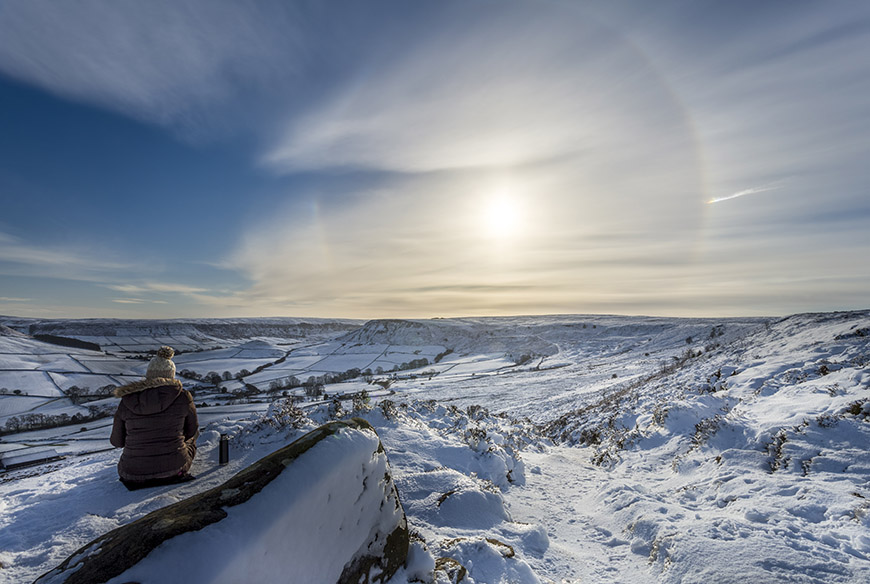The National Park doesn't perhaps have the extreme terrain of other upland regions, but Yorkshire weather can be unpredictable, while the North York Moors present their own challenge to walkers.
Your safety is always your responsibility.
You can stay safe by following a few simple rules and bearing in mind the following advice.
Weather, clothing and route conditions
- For up-to-date weather forecasts, visit the Met Office website
- Hill fog on the moors or coastal sea 'frets' can descend even in summer, reducing visibility to a few metres. Moorland paths can be rough and uneven under foot. Woodland and forest paths can be wet, muddy and slippery at any time of year. Wear appropriate clothing and footwear, even on the shortest walks.
- Our sea cliffs and moorland escarpments are dangerous – it's not just the possibility of falling off them but of rocks falling from them. The cliffs can slump, and escarpment edges can crumble, so stay away from the bottom as well as taking care on the top.
- On coastal walks, check the tide times. The sea comes right up to the cliffs at high tide (and it does it twice a day).
- In dry weather there is a higher risk of moorland fires, started either accidentally or through carelessness. Pay attention to local notices about fire risks, including possible path closures. All moorland is closed at times of exceptional fire risk.
- Winter walking presents other challenges, especially on the high moors. Make sure you have additional warm and waterproof clothing, and allow enough daylight time to complete your walk.

Navigation
Our downloadable walking routes follow established paths and waymarked routes in the National Park, and are designed to be easily followed. But we always recommend that you take a map – you can buy Ordnance Survey maps of the North York Moors (OL26 and OL27) from our National Park Centres at Sutton Bank and Danby, and other local outlets.
- Carry a map and compass that you know how to use. Don't rely on your GPs or handheld SatNav device alone, as batteries can fail and signals can be lost
- Mobile phone reception is patchy in the North York Moors – please don't rely on your phone to get you out of trouble as many areas have no signal coverage
What3words
- Download the free what3words app before you head out on the hills. what3words is a simple way to talk about a precise location. It has divided the world into 3m squares and given each a unique 3 word address – so you can refer to any location with just 3 words. For the starting point of some of our remote guided walks you’ll see 3 word addresses in the form ///word.word.word. To find this place easily, open the what3words app and enter the 3 words into the search bar. To navigate press the directions arrow in the app and select your preferred app (e.g. Google Maps) to travel to that precise point.
- The app also works offline and is compatible with offline navigation apps including Outdoor Active. The emergency services and Mountain Rescue teams are also making use of it to help locate people in more remote locations. While it doesn't substitute for a map when route planning, it is another useful tool for emergencies.
Livestock and animals
- Please read our guidance on walking with dogs.
- Move carefully and quietly through fields with livestock, particularly in spring when animals are rearing their young. Cattle may react to your presence, especially if calves are present. It's best to walk around the herd if possible (you can nearly always find another way to join your route), and don't get between cows and their calves.
- You may be lucky enough to see an adder, especially in spring when they bask in the sun on paths and walls. However, at this time of year they are sluggish and cannot always move quickly away from people and dogs. Adder bites can be serious, so if bitten seek medical attention. If a dog is bitten, it should be picked up and taken to a vet.
Lyme disease
Lyme disease is a bacterial infection transmitted to people by ticks.
- You can pick up ticks by brushing through tall vegetation like bracken, but you can minimise the risk by wearing long-sleeved shirts and leaving no gap between footwear and trousers. Insect repellent may also help.
- If you find a tick on your skin, do not try to squeeze, twist or crush the tick with your fingers – remove it with a proper tick-removal tool or seek medical advice. Never use a lit cigarette end, a match head or essential oils to try and force the tick out. Ticks are very small and their bites can go unnoticed at first. A common symptom of Lyme disease is a red circular rash (the so-called ‘bull’s eye’ rash) appearing anywhere on the body.
- For more information see the advice offered on the NHS Choices and Lyme Disease UK websites, and download the information sheet from Public Health England.
Other issues
- It's important to avoid transferring soil and other organic matter (including leaves) from one place to another in the National Park, to minimise the risk of spreading habitat infections like ash dieback disease (Chalara fraxinea). Always follow any advice posted on signs and keep up-to-date with developments on our website.
